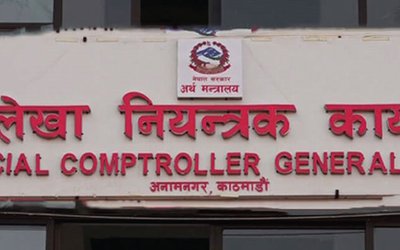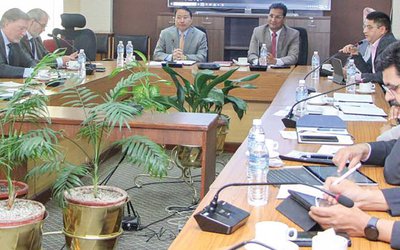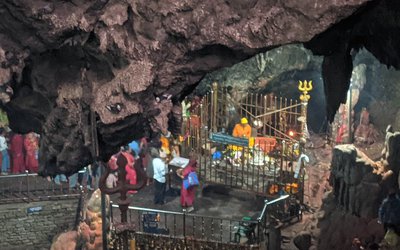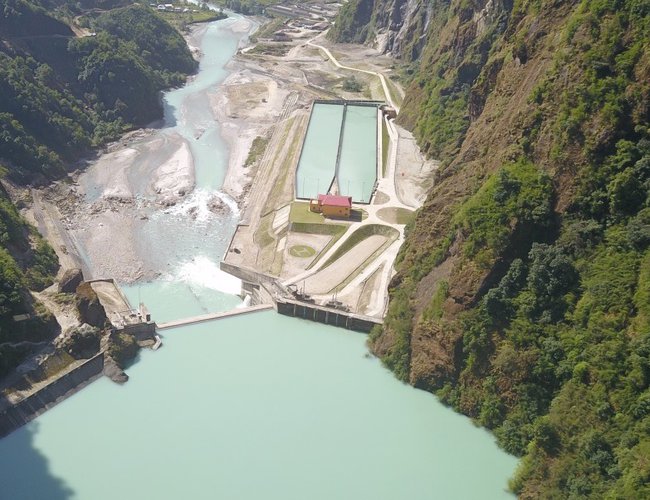
For the first time in the last ten years, Upper Tamakoshi Hydropower Limited (UTKHPL) has shown revenue collections of Rs. 1,727,751,940.08 till 31 Awsin 2078 (17 October, 2021) first quarterly financial disclosures.
As the project has started commercial production from all units on September 10, the revenue generated by the project has shown that it will generate around Rs.9 billion annually from this year. The increase in the share prices of the UTKHPL shows that the faith of the people has increased in the project. The share is trailing from 507 to 904. This indicates that there is growing confidence in the public regarding the future of the project. People are expecting more dividends in the process.
Involved in the project from inception in different positions along with first CEO Dr. Mrigendra Bahadur Shrestha, who had completed all the preliminary works to commence constructions, Chief Executive Officer of UTKHPL Bigyan Shrestha, who has led the competent team of NEA to complete the mammoth project, is now working to optimize the benefit to public shareholders.
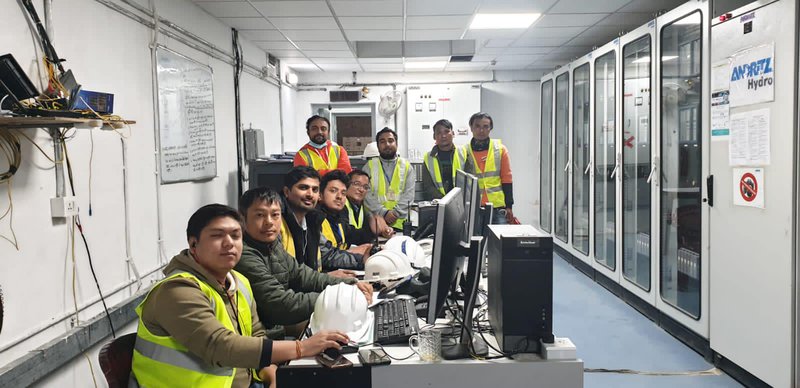
From the construction of roads and conducting a detailed survey of the site and preparing tenders, the first project manager Dr. Shrestha had done everything to materialize the project.
“We are now working on how to provide more benefits from the project to beneficiaries including the public share huddlers,” said Shrestha. “We have completed the mammoth task of completing the project. We have also considered now to start another project like this.”
As the private sector cannot invest in projects like semi-reservoir or reservoir projects like Tamakoshi, the government of Nepal needs to take initiative to construct this kind of project, said Shrestha who spent a long time with the project.
“My sincere thanks go to all helping hands to serve consecutive 33+ years in Nepal Electricity Authority with the accomplishment of 456 MW Upper Tamakoshi Hydroelectric Project in this tenure,” said CEO Shrestha.
Inaugurated in July, UTKHPL started the commercial operation date(COD) from 20 August with 4 units and full-fledged production with all 6 units from September 10, 2021. With this Nepal’s electricity production has reached around 2,000 MW.
After the completion of the project, the country is now self-reliant on electricity.
Despite having adequate production, lack of infrastructure including the transmission lines has led to the wastage of the produced energy.
Paying huge amounts of its revenue to import electricity from India, NEA has proposed to export 456-MW of the UTKHPL and 45-MW of Bhote Koshi Hydropower Project to India, which is yet to be materialized.
Although there are 108 private hydropower projects that have been supplying 815MW of electricity to the national grid, no project is matching to the capacity of Upper Tamakoshi.
With its daily peaking reservoir, UTKHPL can generate energy in full capacity of 456 MW at peak time even during the dry season when the electricity production from the run of the river projects declined drastically.
The plant, the largest hydroelectric project in the country, is located in a remote region of the upper Himalayas on the Tamakoshi River, about 6 km from the border with China’s Tibet. With a natural head of 822 m and six underground units, it produces up to 2,281 GWh of electricity annually. This renewable energy will improve living conditions and promote economic development in the country.
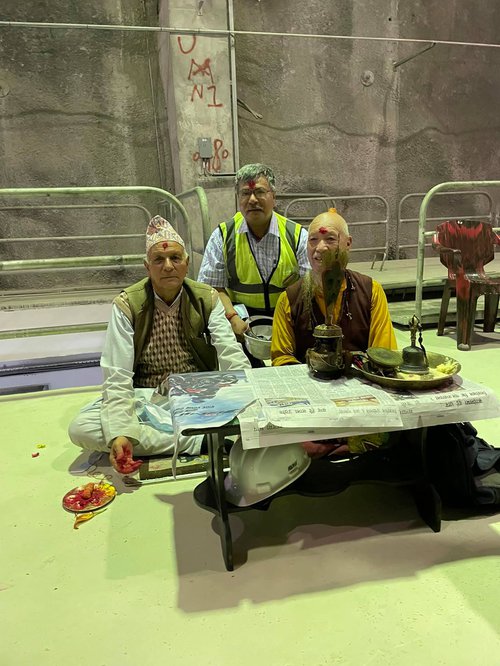
The major components of this project are the intake, a 22-m-high concrete dam, and twin desanding basins, a 7.86-km-long headrace tunnel, a 360-m-high surge shaft, and a 495-m-long penstock pipe, an underground powerhouse with six Pelton turbines, a 2.9-km-long tailrace tunnel, and a 47-km-long 220-kV transmission line to New-Khimti substation.
All six turbines and generators have been in full operation since September 2021. During the rainy season, the total electricity generation of Nepal will exceed what the population and the economy are consuming. The country can benefit in several ways from the surplus of electricity: Electricity costs will decrease, there are plans to supply consumers in need with electricity free of charge, and Nepal could export electricity.
The Nepal Electricity Authority, Nepal Telecom, Citizens Investment Trust and RashtriyaBeemaSansthan are the promoters of Upper Tamakoshi Hydropower Limited (UTKHPL).
The general public has also made a huge investment through the company’s initial public offering (IPO). UTKHPL, executing agency of the plant, is considering a second expansion stage, the 20-MW RolwalingKhola Hydroelectric Project (RKHEP), which would contribute another 105 GWh.
Hydroelectric energy is one of the sustainable renewable energies with low-carbon emissions. The use of hydropower as the main source of energy for everyday activities will help to noticeably reduce fossil fuel carbon emissions in Nepal.
The 456 MW Upper Tamakoshi Hydropower Project, Nepal's largest so far, reached a milestone on July 16 with one of its six 76-megawatt units starting power generation. For the run-of-river hydropower project, which will have little or no storage capacity, the winter [December-February] is the dry season when Nepal’s Himalayan peaks do not melt and the low water flows lead to lower energy availability.
The Upper Tamakoshi plant, however, can generate electricity at full capacity for minimum of four hours during the dry season, according to the project. This is a historic achievement. This makes Nepal a power surplus country capable of exporting electricity.
As a major project in Nepal, this is the largest and most technically difficult, with an underground powerhouse, which is an engineering marvel.
Given its production capacity, the Upper Tamakoshi Hydroelectric Project is of high economic importance to Nepal as it has not only made Nepal an energy surplus country. But it also contributes to the national gross domestic product. Besides those imports, it also cut the import of electricity from India in the dry season-saving billions.
According to the study, the project is expected to contribute around 1 percent to the GDP also help boost industrial production. The completion of the project has shown that Nepal can collect the fragmented capital within the country and invest in projects like Upper Tamakoshi.
The majority share (51 percent) of the Upper Tamakoshi Hydropower Limited is held by four public entities, namely, Nepal Electricity Authority, Nepal Telecom, Citizen Investment Trust and Rastriya Beema Sansthan.
With the completion of the project and the beginning of the generation, it has boosted the morale and confidence of the Nepalese people. The project has shown that Nepali can now develop these types of projects through their own resources and manpower.
In May 2018, the Nepal Electricity Authority had officially announced the elimination of load-shedding for the industrial sector, a year after relieving residential customers who had suffered never-ending power cuts for decades.
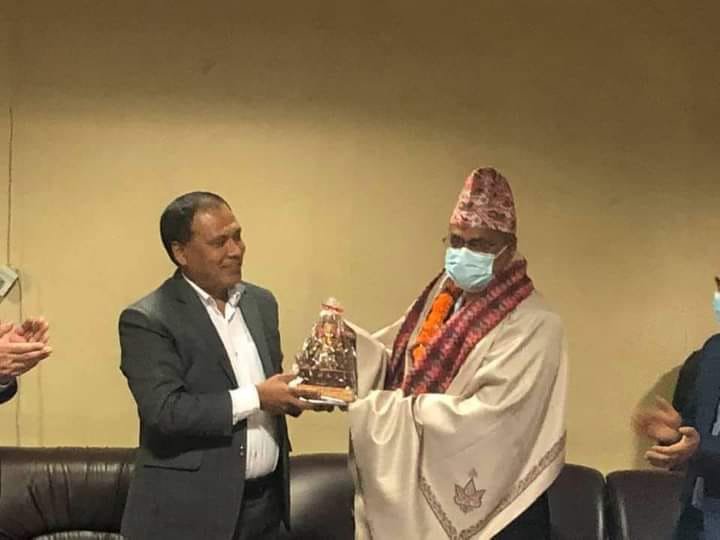
Various reports have pointed out that Nepal has a severe infrastructure investment gap, which is slowing its economic growth. Between 2007 and 2017, the country went through a massive electricity supply shortage that caused up to 18 hours of daily load-shedding.
This load-shedding had drastic costs for Nepal's economy. According to a World Bank report, the reliable power supply would have increased the country's annual gross domestic product by almost 7 percent, and annual investment would have been 48 percent higher.
The six years project began in 2011 to end the power shortage. But like other projects of national importance, this too suffered, resulting in massive cost and time overruns.
According to him, initially, the interest to be paid was estimated at Rs14 billion. “Now, the bank interest alone stands at Rs32 billion. So, the overall cost is around Rs 86 billion.” The annual interest rate has been set at 11 percent in early loan agreement, however, it raised up to 12% for some years during construction.
On the one hand, the project is a milestone for a country like Nepal facing an infrastructure gap but it is also a reminder of how cost and time overruns impact the development aspirations
The national pride project was originally scheduled to be completed in mid-July 2016, but the 2015 earthquakes hit the project very hard. The access road leading to the project site was totally destroyed when the project had completed 79 percent of the civil works. The installation of the penstock pipes was slated for 2015. But that too saw a setback.
The construction work stopped for months when the hydro-mechanical contractor, Texamo Railway Engineering of India lacked the expertise to execute the difficult task of installing the penstock pipes including hydro-mechanical works.
Subsequently, the project developer, the Upper Tamakoshi Hydropower Limited, appointed Andritz Hydro to fit the high-pressure steel penstock pipes when the contractor Texmaco abandoned the project after completing more than 95 percent of the construction work.
In January 2019, Upper Tamakoshi Hydropower Limited, Texamo and Andritz signed a tripartite agreement under which the Texmaco assigned the task of installing the penstock pipes to the Austrian company. With this agreement, the plant was then expected to come into operation by mid-June 2020, but the Covid-19 pandemic pushed back its operation deadline again.
While the officials at the power utility are happy to begin the electricity trade, former Prime Minister KP Sharma Oli had said that efforts should be made to minimize the cost of electricity for general consumers and industries after adequate electricity was available.
With the average power purchase agreement (PPA) rate of Rs 4.06 per unit, it is the cheapest price of electricity for the Nepal Electricity Authority. It is beneficial for the power utility for use of peaking run-off-river (PRoR) synergy. Even after paying back the loans within a reasonable extended time, it can generate a good amount of income in future and more power projects can be developed with it.

Keshab Poudel
Poudel is the editor of New Spotlight Magazine.
- ECONOMY: Growth At 3.3
- Apr 16, 2024
- DPM’s SHRESTHA’S CHINA VISIT High Profile, Low Key
- Apr 14, 2024
- Maha Kumbha In Barahkshetra: A Sacred Festival In Sacred Koshi (Kaushiki) River
- Apr 09, 2024
- LOSS AND DAMAGE: Upper Tamakoshi A Case
- Apr 02, 2024
- Helvetas-Nepal’s InElam Promoting Herbal Oil In Sarlahi
- Mar 31, 2024





